The end of the world is nigh…or so the theory goes according to modern interpretations of the ancient Maya calendar.
One of the greatest Pre-Columbia civilizations, capable of competing with the Aztecs and Incas, the Maya folk lay foundations through much of Central America, stretching from the state of Chiapas and the Yucatán Peninsula in Mexico down through Guatemala, Belize, Honduras, and El Salvador.
Historians can trace the Maya back as far as 2,000 B.C., but little is know about why, during what appears to have been the height of their power, the Maya civilization dramatically declined, leaving grand pyramids and settlements to be consumed by jungles until their re-discovery many centuries later. Revolution, drought, and over population are only a few of the theories offered by way of explanation, and hot debate continues to this day. However, the topic circulating with increasing prevalence as this year gathers pace is not the fall of the Maya empire, but rather the extinction of our own.
Based on readings of the ancient Maya calendar, theory has it that on December 21, 2012 cataclysmic or transformative events will occur, which many believe will spell the end of the human race. These predictions are founded on the tradition of Maya astronomers who classified time by eras using the Mesoamerica Long Count Calendar. The Maya believed that there had been three worlds before ours with the last era ending after a 5,125-year cycle, and our current era commencing on 3114 B.C. Extrapolating this method, theorists have deduced that the end of the next Maya cycle will fall on December 21, 2012.
Whether you’re a believer, non-believer, or simply mildly curious about how December 21, 2012 will come to pass, what can be agreed almost universally is the impressive nature of the ruins that comprise the Ruta Maya.
In the eyes of some, the December date foretells a totally catastrophic event such as the earth colliding with a passing asteroid, while more positive theorists associate this date with the coming of a new era that spells more of a spiritual transformation with a unique planetary alignment. Other scholars dismiss the theories entirely, accepting that the event would have been of significance to the Maya, but noting that there was no indication of the end of the world featured in their records.
Despite the fact there is a fundamental lack of agreement among the theorists, this hasn’t prevented strong reactions in certain corners of the globe, including the increased sale of underground bunkers in the USA, the encouragement of food stock-piling in Brazil, and most opportunely, Mexico’s use of the date to rejuvenate tourism numbers, including the installation of a gigantic digital countdown clock in Tapachula, Chiapas. During my travels through Central America, I came across a fellow backpacker who has commenced his own countdown comprising a switch to a purely hedonistic lifestyle (which in practice equalled heavy substance use and cessation of showering) to make the most of what little time he believed he had left on this earth.
[social]
Whether you’re a believer, non-believer, or simply mildly curious about how December 21, 2012 will come to pass, what can be agreed almost universally is the impressive nature of the ruins that comprise the Ruta Maya. Using the present hype to pique your intrigue, here are 10 of the Maya highlights plotting a route from Mexico down to El Salvador.
1. Tulum, Mexico

The colossal and contrived coastal resort of Cancun is the hub for flight arrivals into the Yucatán and can be happily missed unless you want a slice of American tourism that comes complete with a yard long plastic beaker of slushy margarita. On the plus side, Cancun is a mere two-hour jaunt to the Maya site of Tulum. Although the ruins at Tulum may not tick the box of most impressive when it comes to site expanse and structure (they can be visited in less than an hour), what makes Tulum stands out on the route is its location. Grey remnants against the backdrop of the vivid turquoise Caribbean Sea offers a stark contrast that makes for pretty impressive photographs. Add to that the possibility to take a mid-humidity dip in the Caribbean after your sightseeing, and it’s not difficult to be persuaded of the attraction of Tulum.
Check out our new Mexico Travel Guide and book a flight to Cancun
2. Cobá, Mexico

Idle a mere 45 minutes from Tulum, easily done by day trip, and you can stumble across the neighboring ruins at Cobá. However, despite its proximity, the sites are quite different; in fact, Cobá’s sister site, if assessed in terms of similarity, would be the ruins in Guatemala’s Tikal. Cloaked in jungle and surrounded by lakes, the site takes much longer to get around compared to Tulum on account of the jungle trails and ability to climb up the ruins, and half a day is recommended to explore the place properly. Somewhat surprisingly, Cobá doesn’t attract as many visitors as nearby Tulum, and with an early start you can recreate your own Tarzan (or Jane) in the jungle scene as you’re likely to be one of few people around.
Find a hostel in Mexico and check out adventure trips in Mexico
3. Chichén Itzá, Mexico

With a good few days’ rest to avoid Maya-ruin-overdose, the famous site of Chichén Itzá is the next natural port of call. Happily reached from cosmopolitan Mérida (2 hours) or quaint Spanish Colonial Valladolid (1 hour), the site of Chichén Itzá is one of the most popular and draws in tourists by the coach load, including day-trippers from Cancun, Playa del Carmen, and Tulum. However, don’t let that put you off. The site, which was recently named as one of the New Seven Wonders of the World, is astounding and merits a visit despite the tourist hoards. There is something about the near perfection of El Castillo (the Castle) that makes you stand and stare even if the site has been so extensively cleared of jungle you practically step from the vast car park into the midst of the ruins.
Find a cheap flight to Merida and read Why You Should Ignore All the Urban Legends and Take the Kids to Mexico
4. Uxmal, Mexico

Another hour and a half on from Mérida heading southwest are the ruins of Uxmal. The Pyramid of the Magician is the most wow-worthy and is one of the best preserved Maya ruins around. Characterized by its smooth walls and sloping sides, the pyramid is deeply reminiscent of El Castillo but located in a spot that thankfully lacks the tourist levels of Chichén Itzá, making a visit to Uxmal a breath of fresh air both metaphorically and literally given the absence of the exhaust fumes kicked out by the coaches at Chichén Itzá. Don’t forget to impress the locals with your language skills by remembering that the ‘Ux’ in ‘Uxmal’ is pronounced ‘oosh’.
Let us help you plan a trip around Central America
5. Palenque, Mexico
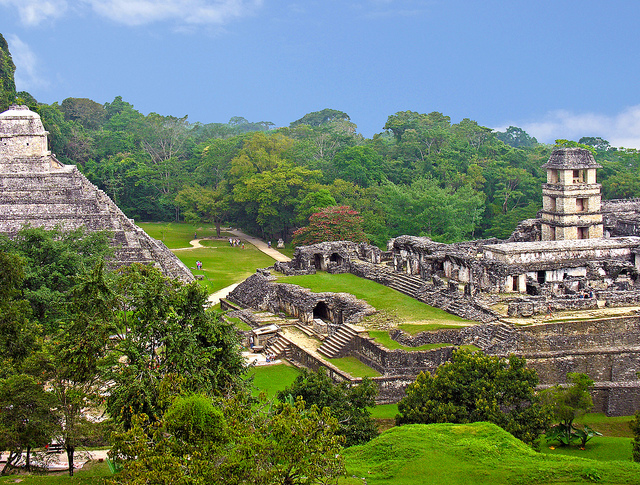
Switch from the Yucatán to the state of Chiapas for a trip to the site of Palenque, which lies around 8 hours southwest from Mérida. Venture this far out and visitor numbers drop dramatically, meaning it’s not much of a challenge to find yourself as one of only a handful of others at the site – unless local school children arrive in their screaming masses as happened briefly during my visit. School excursions aside, don’t be surprised to see people practising yoga or meditating at the site, which has one of the most tranquil ambiances along the Ruta Maya. Pack a picnic, a good book, and find a tree for the chance to relax within some pretty impressive surroundings. The museum near the entrance to the ruins is worth a brief visit for its displays, but also to escape the heat of the day. Although Palenque town isn’t a particularly stunning or engaging place to stay, a night in one of the jungle cabanas near the ruins can make a pleasant break from hostel dorms.
Read South of the Border: 3 Mexican Road Trips for the Intrepid Traveler
6. Tikal, Guatemala
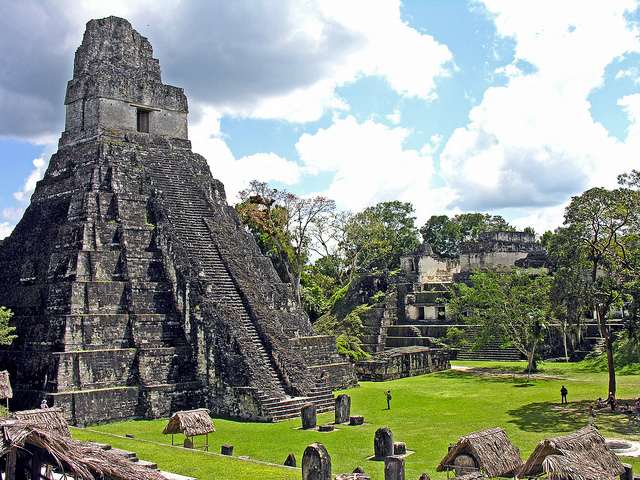
From Palenque it’s easy to cross the border into Guatemala, taking a bus to Frontera Corozal, and from there it is possible to change countries gliding along the River Usumacinta. Another bus completes the jaunt to Flores, the lake front town that is especially popular with indie travelers planning to visit Tikal, and can be reached from Palenque in around 10 hours. On from Flores to Tikal is a short trip of around 1 hour, and although an early start is recommended to avoid the coach crowds (which compete with the numbers at Chichen Itza), don’t be fooled into thinking you’ll arrive in time to see sunrise as the park gates don’t open until 6am for those who aren’t staying at the park. That said, a trip to Tikal at any time of day is far from disappointing, and this spot is my favorite on the Ruta Maya. Temples are strewn across the vast site, many of which are still ensconced in jungle, and it is still possible to climb up near vertical, precariously knocked together wooden steps for access to views that makes Tikal stand out from the rest of the Maya sites. The best view by far is that from atop Temple IV looking back across Temples I, II, III and V, peeking through the jungle canopy while the calls of vivid parrots, toucans, and if you’re lucky, howler monkeys, ring through the sky.
Find a flight into Guatemala and check out adventure trips in Guatemala
7. El Mirador, Guatemala
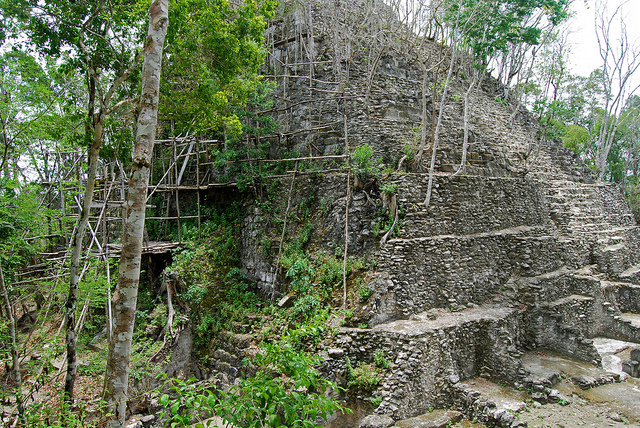
Towards the border with Mexico, northwest of Flores and close to the town of Carmelita, is one of the more remote Maya sites, El Mirador. Set in a basin and surrounded by rainforest and limestone hills you’re certainly not going to see any coach loads of tourists at this site. To reach it involves a gruelling trek that takes several days and features conditions so basic that you’re likely to encounter more ticks (take tweezers) than tourists, toilets, and showers. The journey truly is as much of the trip as the destination, and a guide approved by the Cooperativa Carmelita is highly recommended to avoid being turned back by machete toting guards and to ensure as much money as possible finds its way into the hands of the local communities. The tourism situation is complicated in the region, so check for best advise before you book a trip, but is worth the effort to see El Tigre, the tallest Maya pyramid, which staggers 60 metres high.
Check out our new Guatemala Travel Guide and read a Step-by-Step Guide to Riding the Chicken Buses of Guatemala
8. Lamanai, Belize

From Flores, hop into Belize and up to Orange Walk, a lively town that makes a great start for a trip to Lamanai (reachable within 7 hours from Flores via Belize City). The route to the site of Lamanai is as appealing as the ruins themselves, as it takes a 26-mile path along the New River. Meaning “submerged crocodile” in Maya, Lamanai has extensive ruins that linger on the bluff of the lagoon. The occupation of this site existed long after others had been abandoned, and although many of the ruins remain unexcavated, there are still many to see including Mask Temple, which features a 13 metre stone mask and High Temple, which can be climbed for panoramas.
Find a cheap flight to Belize and read 8 Green Ways to Experience Belize
9. Copán, Honduras
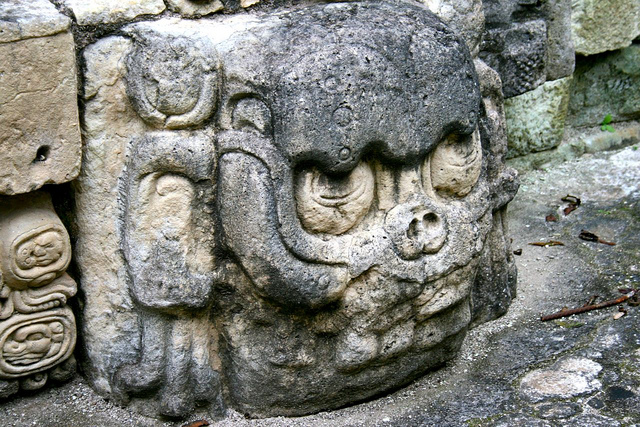
After perhaps taking a short ruin-free break in the Cayes in Belize, get to Honduras from Lamanai either by bus and boat from Dangriga to Puerto Cortės in Honduras, or for a less direct but often cheaper and quicker route divert back into Guatemala by boat to either Puerto Barrios or Livingstone, and then on to the Honduran town of Copán Ruinas. Indie traveler friendly as well as being cast in white Colonial charm complete with cobblestones, Copán Ruinas makes the journey worth the effort, and not least because it is a short meander to the ruins, which sit around 1 kilometre out of town. The site is the grandest within Honduras and has particularly well preserved hieroglyphics and sculptures.
Check out our new Honduras Travel Guide and find a hostel in Honduras
10. Joya de Cerén, El Salvador
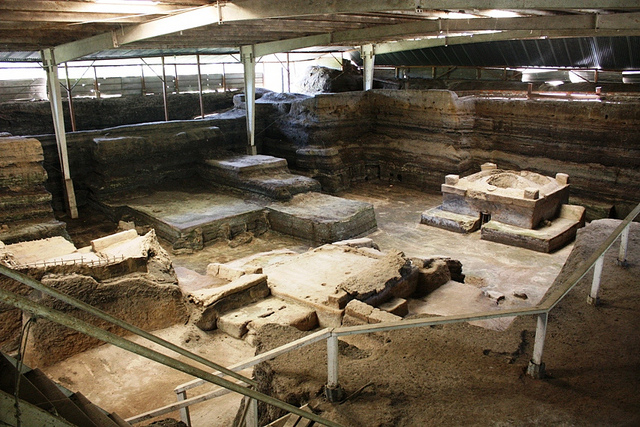
Another border crossing, perhaps after a short side-trip to the Bay Island, travel from Copán to San Salvador via La Entrada and then the Nueva Ocotepeque / El Poy crossing, achievable in around 8 hours. From San Salvador the remains of Joya de Cerén sits a short bus ride away from the capital. Dealt a brutal blow by Laguna Caldera Volcano, which erupted in 595AD, Joya de Cerén is a rather different style of Mayan ruin that was preserved in 14 layers of volcanic ash during the midst of its occupation by Maya farmers. Perfectly preserved (to archaeological delight), excavations have been ongoing since the site’s discovery in 1979. Indicating an urgent need to flee the scene, half eaten food has been uncovered as well as furniture and other remnants that assist the experts in forming a greater picture of Maya life.
Catch a flight to El Salvador and check out our new El Salvador Travel Guide
The Ruta Maya winds a fascinating trail through an inviting swathe of Central America and will put you in close proximity to many other impressive sights along the way. Predictions of the doomsayers aside (which, incidentally, I don’t place much stock in), I do have one thought that has endured since my own trip through Ruta Maya – I wonder what will happen to the hedonistic living traveler I met in Central America if he does wake up on 22 December 2012.
